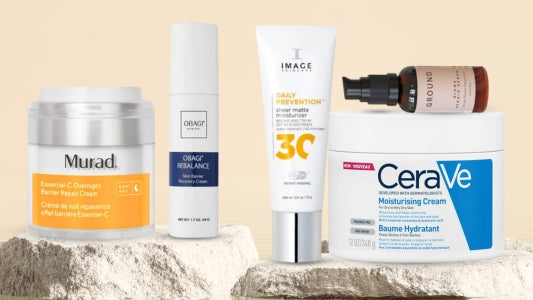
Subscribers Get More
Sign-up & be the first to hear about exclusive BLACK FRIDAY offers & subscriber only promotions.

Sign-up & be the first to hear about exclusive BLACK FRIDAY offers & subscriber only promotions.
Subscribe to our newsletter & be the first to hear about Black Firday offers & subscriber exclusives!
Learn More
Your skin barrier is the unsung hero of your skincare routine—responsible for keeping moisture in and irritants out. But when it’s compromised, your skin can become dry, irritated, and inflamed.
The good news? With the right knowledge and products, repairing it is absolutely possible.
The skin barrier, also known as the stratum corneum, is your body’s first line of defense against environmental aggressors. It's made up of skin cells (corneocytes) and lipids (like ceramides, cholesterol, and fatty acids) that act like a brick wall.
When this barrier is damaged—through over-exfoliation, harsh products, or environmental factors—it can't function properly, leading to water loss and sensitivity. This is what we refer to as a damaged skin barrier.
How do you know if your skin barrier needs some TLC? Watch for these telltale signs:
Persistent dryness or flakiness
Redness or inflammation
Burning, stinging, or itching
Increased sensitivity to products
Breakouts or damaged skin barrier bumps
Tight or uncomfortable skin after cleansing
These symptoms signal that your barrier is compromised and needs repair.
Several factors can damage the skin barrier:
Over-exfoliation with AHAs, BHAs, or scrubs
Using harsh cleansers or stripping soaps
Exposure to cold weather, UV rays, or pollution
Skipping moisturiser or not hydrating properly
Using too many active ingredients like retinoids or acids
Disrupting your skin's pH balance
Even stress, poor sleep, and diet can contribute to skin barrier damage.
Repairing your skin barrier requires a shift in mindset—from aggressive correction to gentle nurturing. Your goal is to support your skin in rebuilding its natural defenses by reducing stressors and adding nourishing ingredients. Here’s a step-by-step guide:
The first and most critical step is to discontinue any products that may be exacerbating damage. This includes exfoliants (both physical and chemical), retinoids, strong acne treatments, and anything with alcohol or fragrance. These ingredients can further compromise the barrier when it’s already vulnerable.
Stick to the essentials for now and allow your skin time to reset. Avoid trying new actives during this healing period.
Cleansing is essential, but it must be done with care. Choose a non-stripping, pH-balanced cleanser that’s free from sulfates, alcohol, and fragrance. A good gentle cleanser should clean without leaving your skin feeling tight, dry, or squeaky.
Opt for cream, balm, or gel-based cleansers formulated for sensitive or dry skin. Use lukewarm water (never hot), and always pat your skin dry with a clean towel—don’t rub.
Hydration is your skin barrier’s best friend. Look for a moisturiser that includes barrier-repairing ingredients like ceramides, glycerin, and hyaluronic acid. These components help replenish the lipids that keep your skin barrier strong and flexible.
Apply moisturiser while your skin is still slightly damp to lock in moisture. Reapply throughout the day if your skin feels tight or dry.
Once you’ve simplified your routine, consider incorporating ingredients that actively support the skin’s recovery:
Ceramides: Replenish the lipid layer and seal in moisture.
Niacinamide: Reduces inflammation, supports elasticity, and helps restore the skin’s structure.
Panthenol (Vitamin B5): Soothes and promotes repair of damaged skin.
Squalane: A non-comedogenic oil that mimics natural sebum and prevents moisture loss.
Start with one or two of these ingredients at a time to avoid overwhelming your skin.
UV exposure can further damage your already compromised skin barrier. Using sunscreen daily is non-negotiable, even if you’re indoors or it’s cloudy. Choose a broad-spectrum SPF 30 or higher that’s formulated for sensitive skin.
Look for mineral sunscreens with zinc oxide or titanium dioxide, which are generally less irritating. Apply sunscreen as the last step in your morning skincare routine, and reapply throughout the day if you’re outside.
As your barrier heals, try to limit exposure to things that can cause irritation. This includes:
Harsh weather (wind, cold, sun)
Dry indoor air – use a humidifier if needed
Long, hot showers or baths
Rough towels or pillowcases – opt for soft cotton or silk
Being mindful of your environment gives your skin a chance to recover fully.
Skin barrier repair doesn't happen overnight. Stick to this simplified, nourishing routine for at least 2–4 weeks before reintroducing actives (and only if your skin feels truly ready). Consistency is key—resist the urge to try new products or treatments while your skin is still vulnerable.
Track your progress by observing improvements in hydration, reduced redness, and smoother texture. Let your skin tell you when it’s healed.
A damaged skin barrier may look:
Dull, dehydrated, or ashy
Patchy, with rough or flaky texture
Red or inflamed, especially around the cheeks or nose
Prone to acne, rashes, or tiny bumps
Thin or translucent in appearance
This visual feedback is your skin telling you it’s vulnerable and needs repair.
Here are our top picks to help speed up your skin’s recovery:
CeraVe Moisturising Cream – Packed with ceramides and hyaluronic acid, this rich cream provides all-day hydration and helps restore the protective skin barrier.
Obagi Medical Rebalance Skin Barrier Recovery Cream – Formulated with BarrierPlex™ Technology, this cream combines postbiotics, ceramides, niacinamide, and green algae to restore and rebalance the skin’s microbiome, strengthening the barrier and soothing irritation.
Murad Essential-C Overnight Barrier Repair Cream – This vitamin C-infused night moisturiser is supercharged with antioxidants to neutralise pollutants, brighten, and smooth the skin while strengthening its barrier overnight.
Revolution Skin Barrier Bounce Soothing Serum – A pink peptide-powered serum with ceramides and vitamin B12 that soothes stressed-out skin and helps to support the skin barrier.
GROUND Biome Repair Cream – A rich, comforting cream that deeply hydrates, strengthens the skin’s barrier, and helps repair damage for smoother, healthier skin. It contains Lactobacillus Ferment, Camellia Kissi Seed Oil, and Sodium Hyaluronate to improve elasticity and moisturize.




